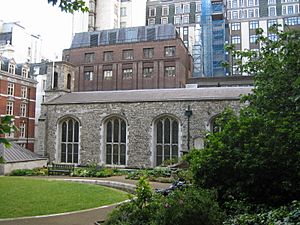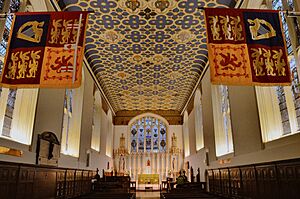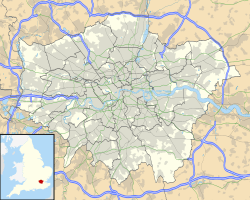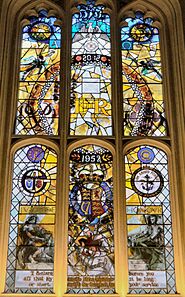Savoy Chapel facts for kids
Quick facts for kids King's Chapel of the Savoy |
|
|---|---|

View of the associated green and the chapel's east side, from Savoy Street
|
|
| 51°30′38″N 0°07′12″W / 51.5105°N 0.1199°W | |
| OS grid reference | TQ 30568 80743 |
| Location | Liberty of the Savoy, near Temple, London |
| Country | England |
| Denomination | Church of England |
| Previous denomination | Lutheran Catholic |
| History | |
| Status | Royal Peculiar |
| Architecture | |
| Functional status | Active |
| Architect(s) | Richard Griffiths Architects (renovations) |
| Style | Tudor; Perpendicular |
| Completed | 1512 |
| Specifications | |
| Length | Nave: 200 ft (61 m) |
| Number of towers | 1 |
| Materials | Stone |
| Administration | |
| Diocese | London (location) |
| Province | Canterbury |
The King's Chapel of the Savoy is a historic church in London, England. It is located in the City of Westminster, near famous landmarks like the Savoy Hotel. This chapel is a very important building, officially recognized as a Grade II* listed building. This means it has special historical or architectural value.
The chapel stands on the site of the old Savoy Palace. This palace once belonged to a powerful prince named John of Gaunt. Sadly, the palace was destroyed during the Peasants' Revolt in 1381. The land then became part of the Duchy of Lancaster, which is owned by the British monarch.
Work on the chapel began in 1502 under King Henry VII. It was first set up in 1512 as part of a hospital to help 100 poor men in London. Over time, the hospital fell into disrepair and was torn down. Only the chapel survived.
Today, the chapel is still owned by the Duchy of Lancaster. This makes it a Royal Peculiar, meaning it is directly under the control of the reigning monarch, not a local church authority. It is also the official chapel for the Royal Victorian Order, a special group recognized by the monarch. In 2016, it became part of the Chapel Royal, giving it an even closer link to the royal family.
Contents
History of the Chapel
The original palace on this site was built by Peter II, Count of Savoy. After it was destroyed in the 1381 Peasants' Revolt, King Henry VII started building the current chapel in the 1490s. It was finished in 1512. The chapel was originally a smaller part of a much larger hospital building.
Over the years, the Savoy Chapel has been used by different church groups. For example, the congregation of St Mary-le-Strand worshipped here for many years when their own church was being built. A Lutheran church group from Germany also used the chapel with royal permission starting in 1694.
In the 18th and 19th centuries, the chapel became known for allowing weddings that were not usually permitted by church rules at the time. One famous example was the wedding of Consuelo, Duchess of Marlborough, in 1921. However, a later chaplain, Rev Cyril Cresswell, stopped this practice.
In 1912, the chapel hosted a suffragette wedding. This was between Victor Duval and Una Dugdale. The bride famously refused to say "and obey" in her vows. This caused a lot of discussion at the time.
In 1939, it was officially announced that the chapel would be known as The King's Chapel of the Savoy.
During the London Blitz in World War II, many of the chapel's stained glass windows were destroyed. However, one beautiful stained glass window survived. It shows angels playing music and honors Richard D'Oyly Carte, who built the nearby Savoy Theatre and Savoy Hotel.
The Chapel Today

The King's Chapel of the Savoy has been owned by the Crown for centuries. It is still part of the Duchy of Lancaster and is a Royal Peculiar, meaning it's directly linked to the monarch. In November 2016, it was officially made a Chapel Royal.
The chaplain, who leads the chapel, is chosen by the Duchy of Lancaster. The chapel acts like a local church for the Savoy Estate, which is a large area of land in London owned by the Duchy. Inside the chapel, you can see special plates that honor members of the Royal Victorian Order.
The Duchy of Lancaster pays for most of the chapel's upkeep and repairs. Recent work includes making the garden look nice for the Golden Jubilee of Queen Elizabeth II in 2002. The chapel ceiling was also restored in 1999. In November 2012, a new stained-glass window was added to celebrate the Diamond Jubilee of Queen Elizabeth II. The Queen herself unveiled it.
The Savoy Chapel uses traditional church books for its services. These include the 1662 Book of Common Prayer and the Authorised King James Version of the Bible. Services are held every Sunday, and everyone is welcome to attend. The chapel is also open for visitors from Monday to Thursday.
Music at the Chapel
The Organ
The chapel has a large pipe organ with three keyboards. Queen Elizabeth II gave this organ to the chapel. It was built by J. W. Walker & Sons Ltd. The organ's beautiful wooden case was designed by Arthur Bedford Knapp-Fisher. The organ was officially dedicated on October 27, 1965. The Queen attended the service to celebrate the 700th anniversary of the Duchy of Lancaster.
Organists and Music Directors
The person in charge of music at the chapel is called the Master of the Music. Philip Berg has held this role since 1995. Justin Luke has been the sub-organist since 2002. Famous past Masters of the Music include William Cole, who served from 1954 to 1994.
The Choir
The chapel's choir follows the style of English cathedral choirs. It has up to 21 boy choristers (aged ten and older) and six professional adult singers. The boy singers come from St Olave's Grammar School in Orpington. Each year, a few students are chosen to join the choir after passing singing and academic tests.
Choristers are expected to stay in the choir until their voices change. They practice three times a week at school and once a week at the chapel. The boys who join in year 6 are called Wakeham choristers. This is to honor Michael Wakeham, who was involved with the choir for 49 years.
The choir sings at Sunday morning services, including Eucharist (Communion) or Matins. They also sing for special events like Christmas and Easter services, weddings, and royal occasions throughout the year.
See also
 In Spanish: Capilla del Savoy para niños
In Spanish: Capilla del Savoy para niños




